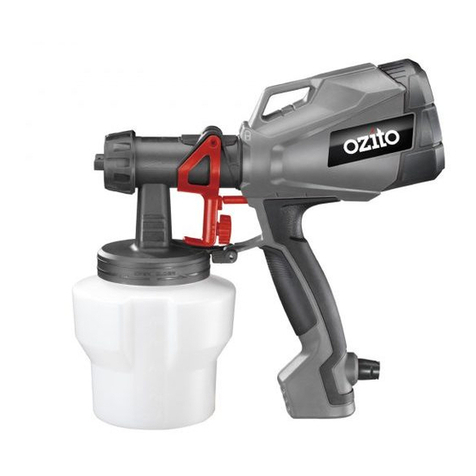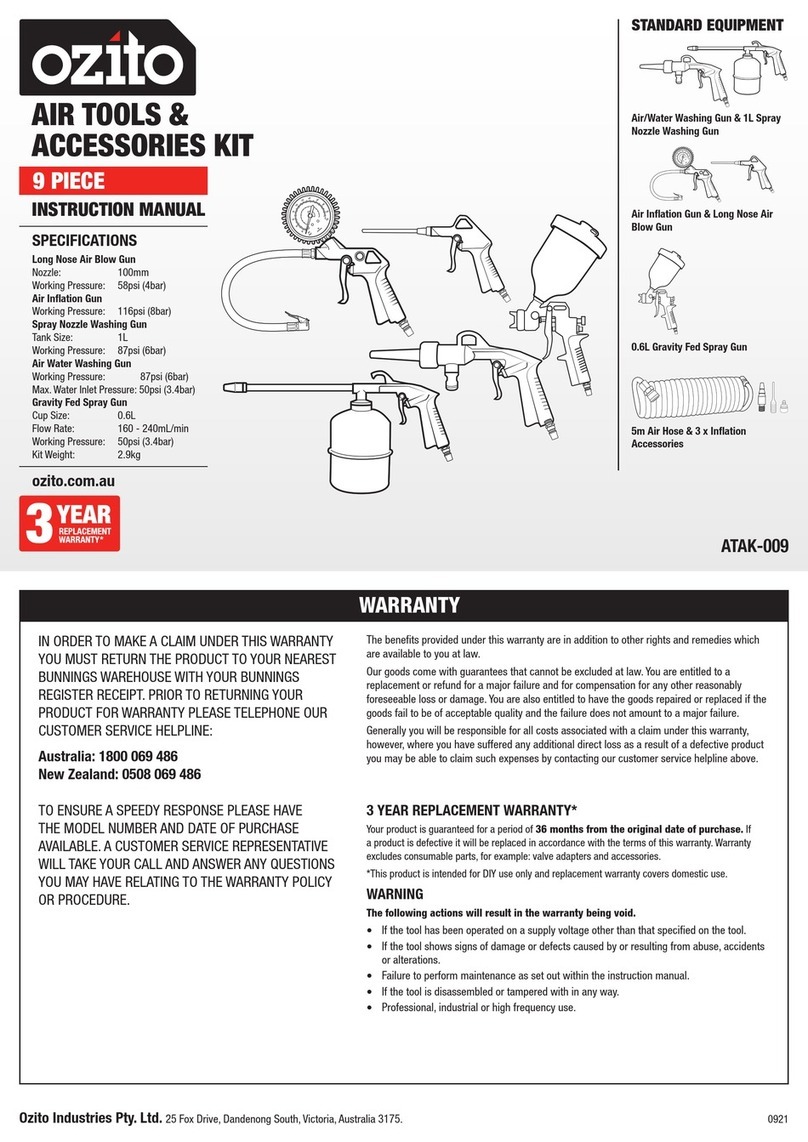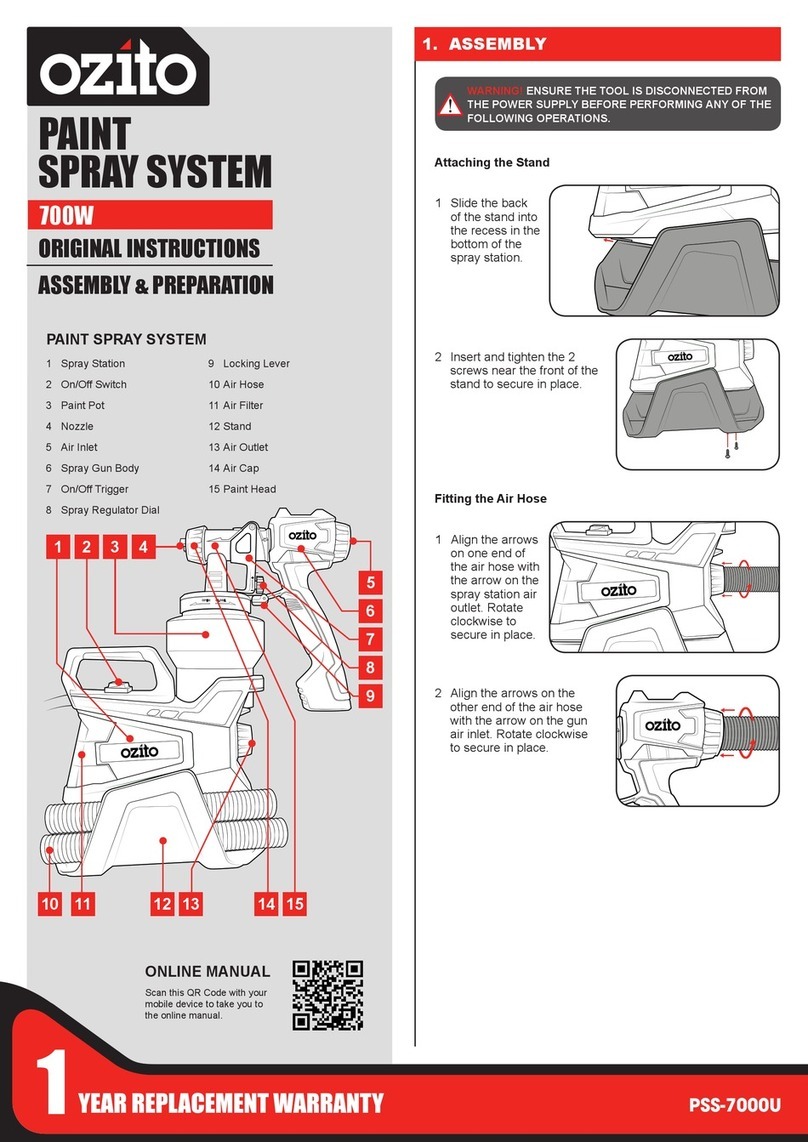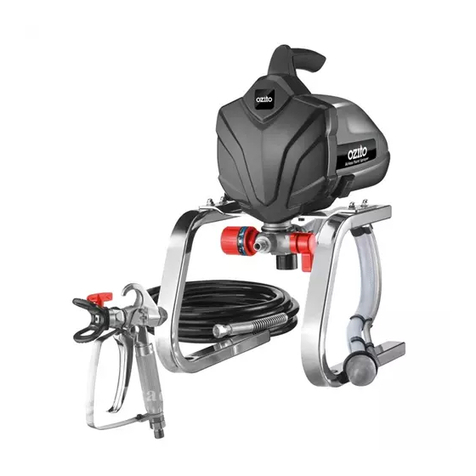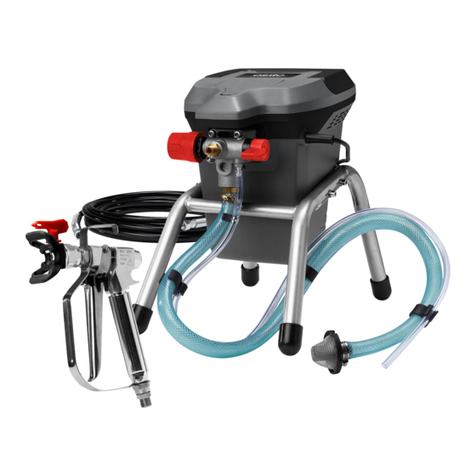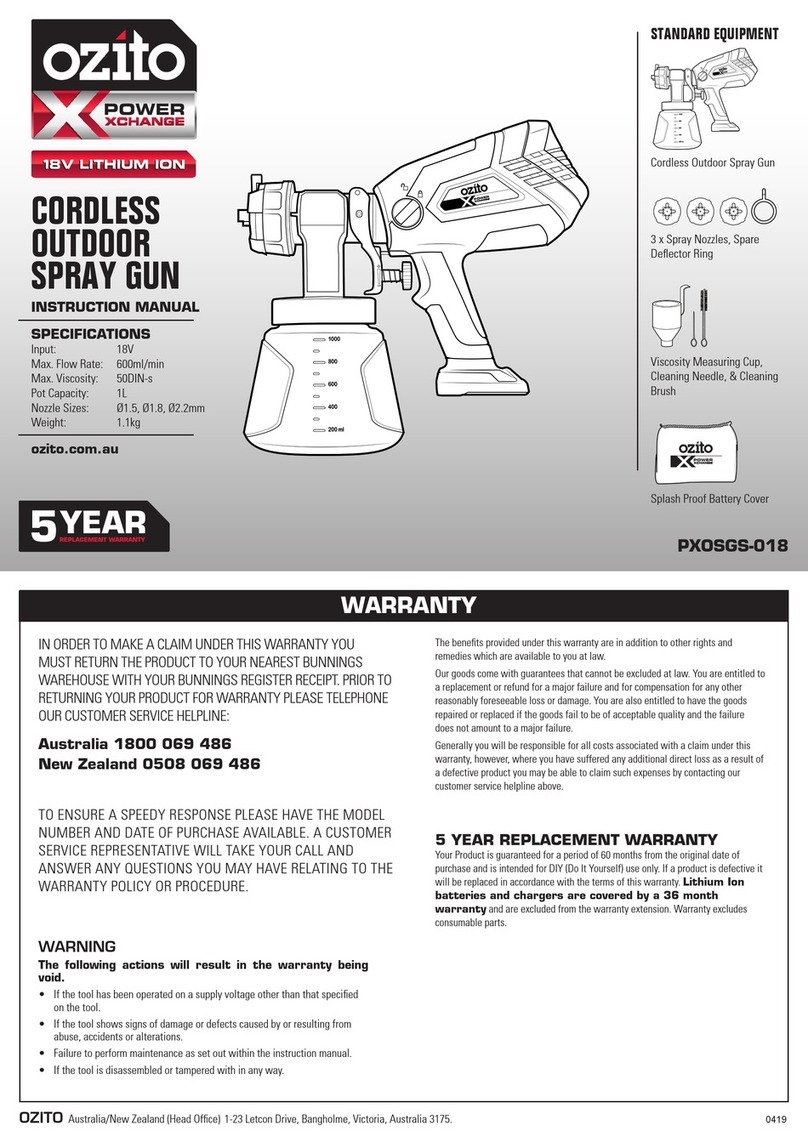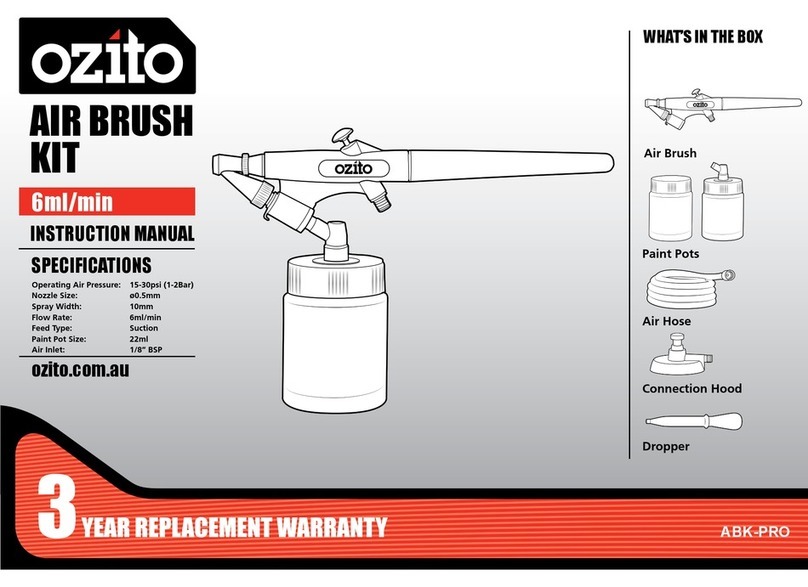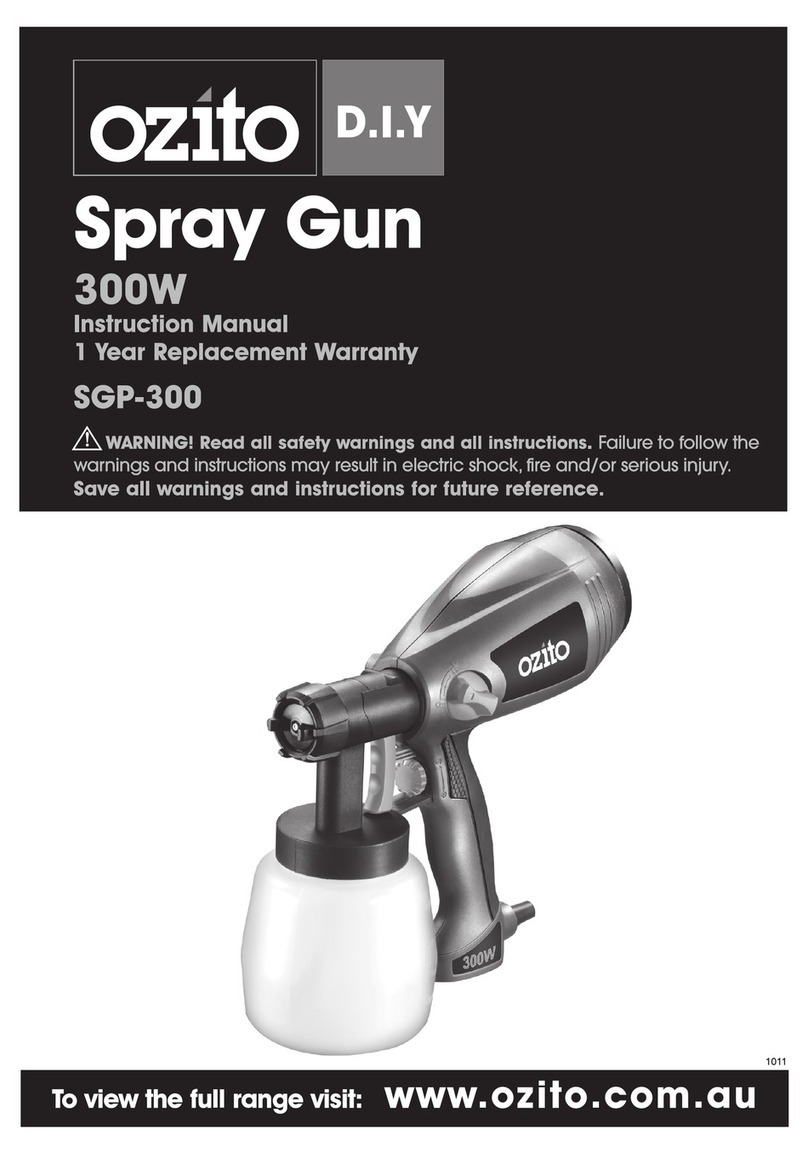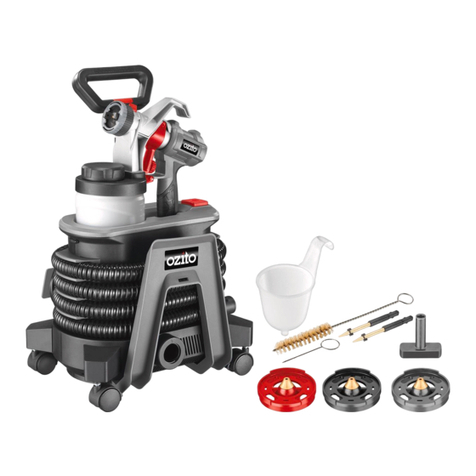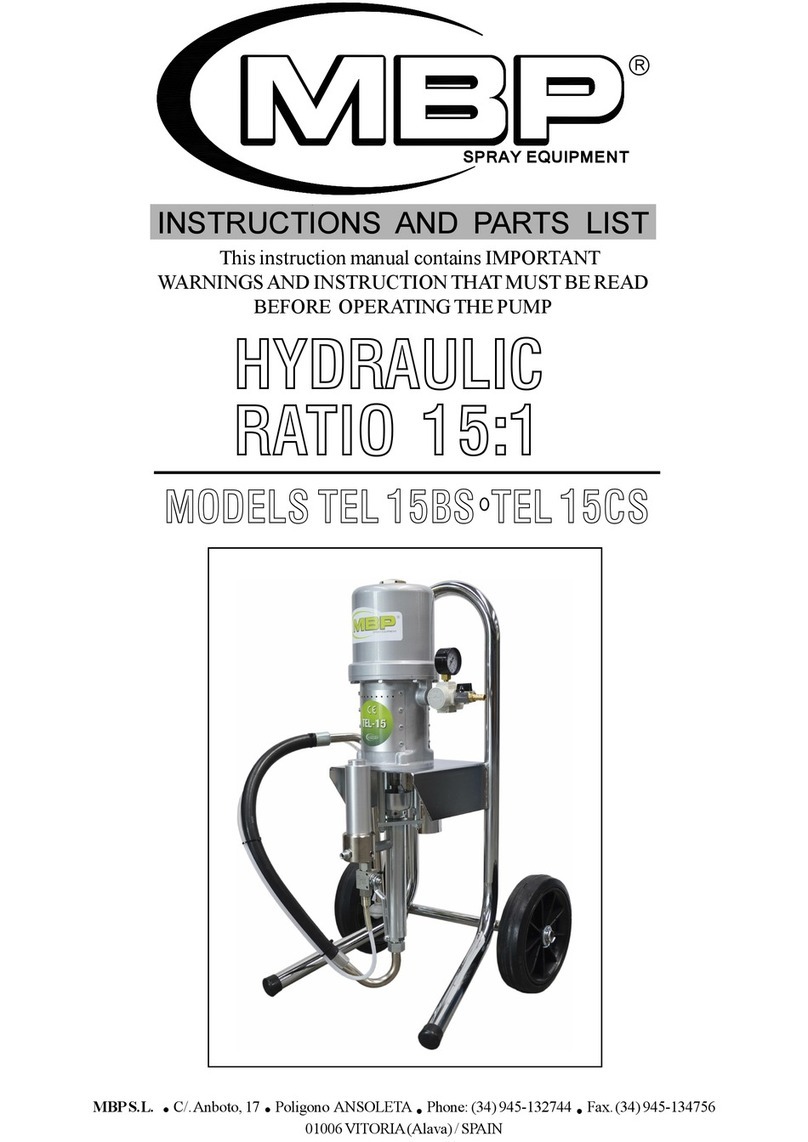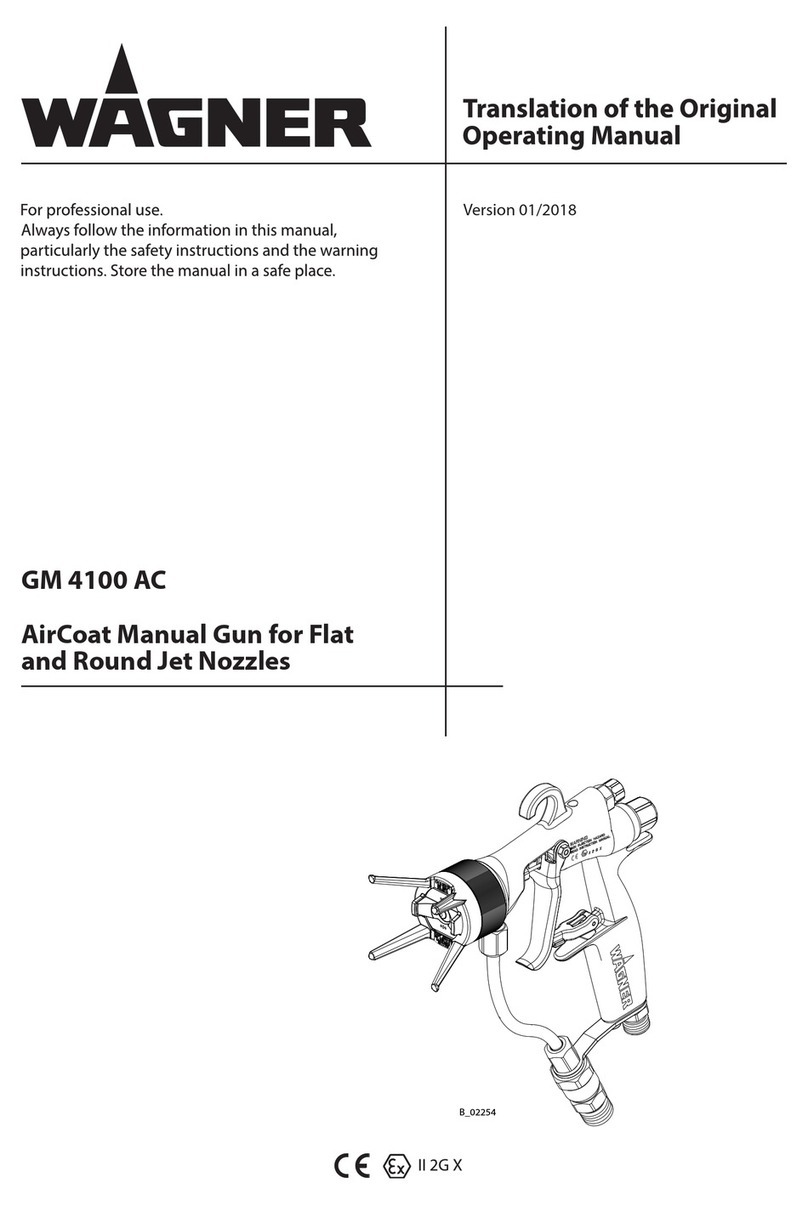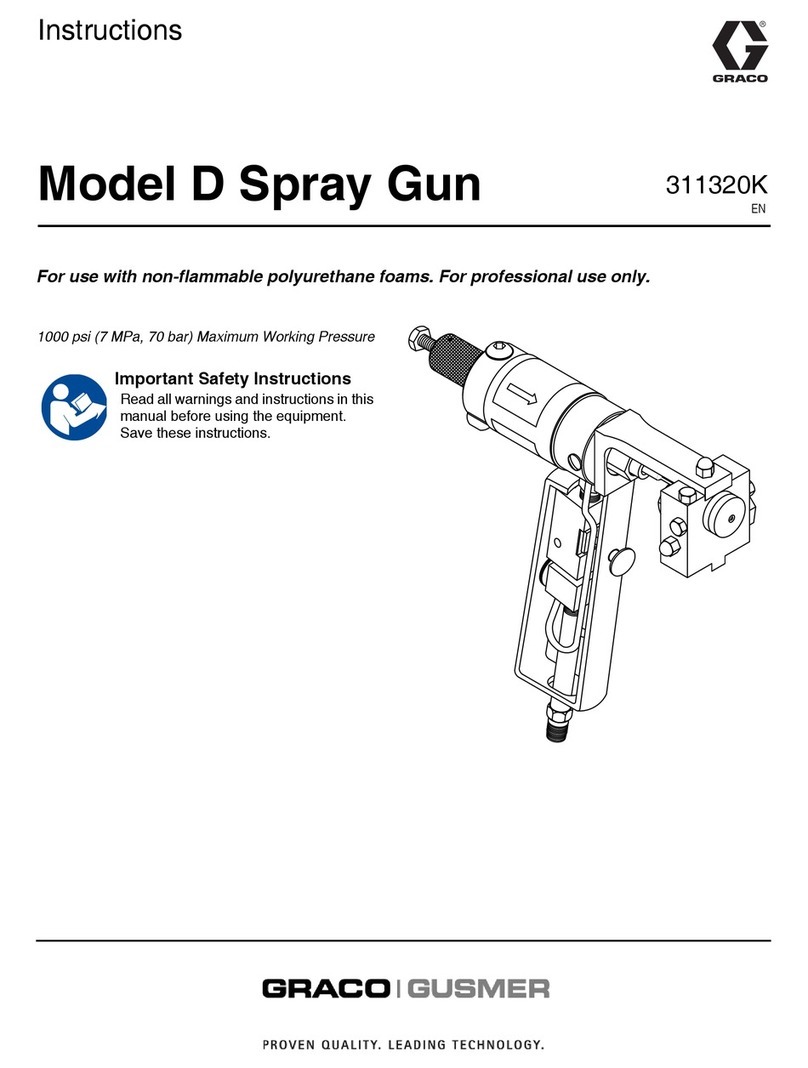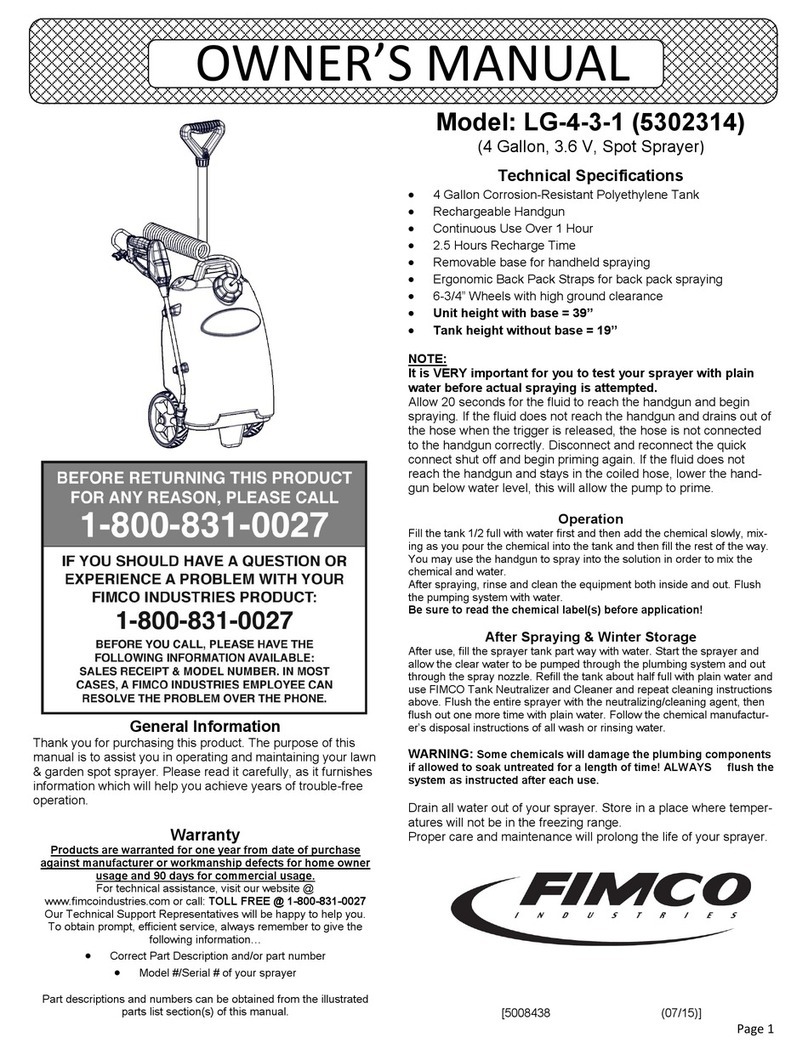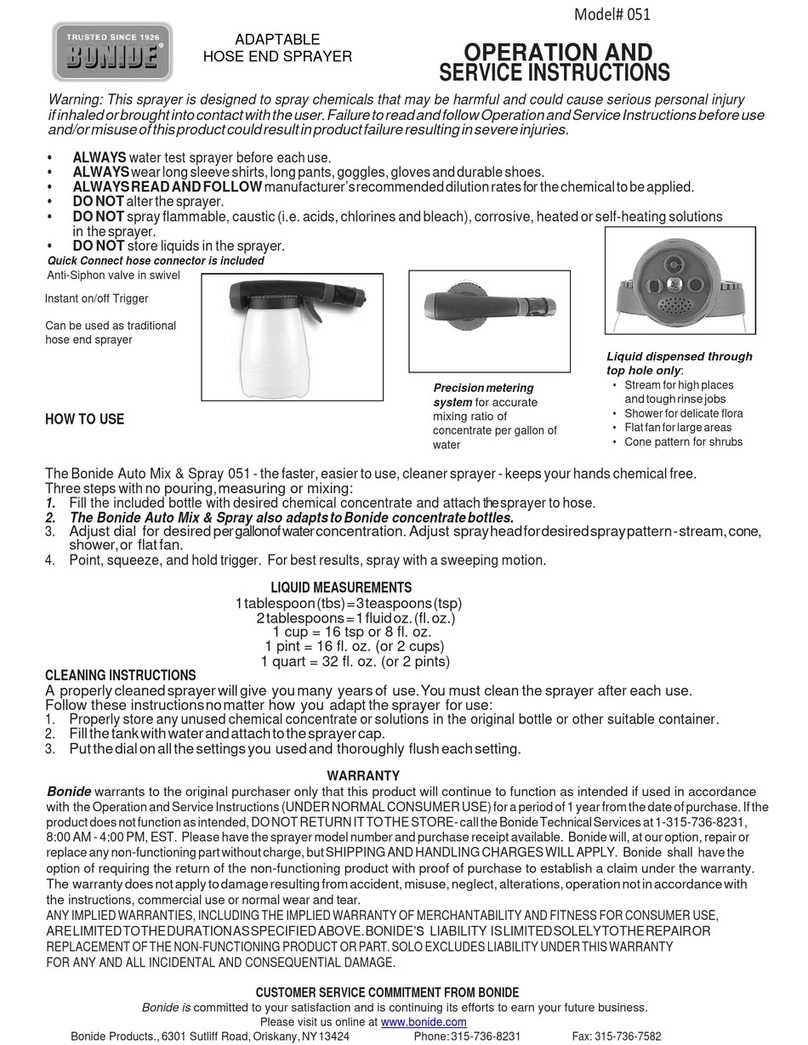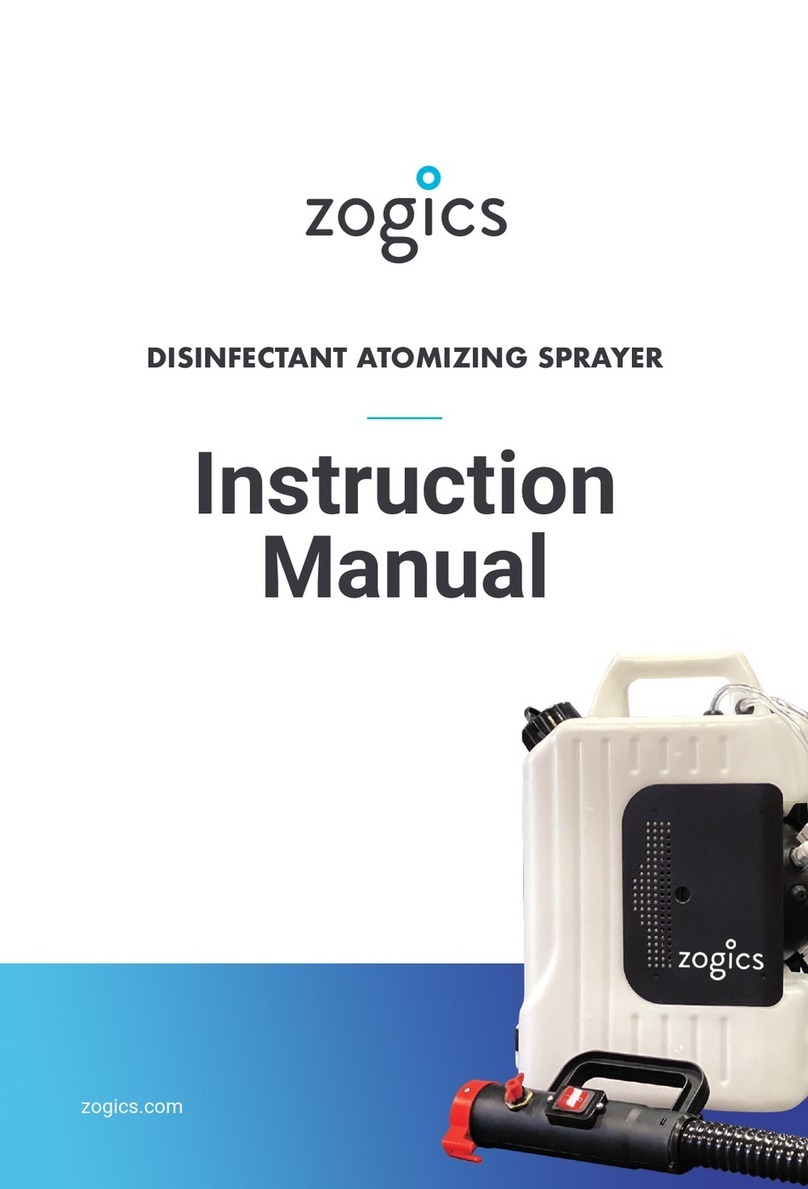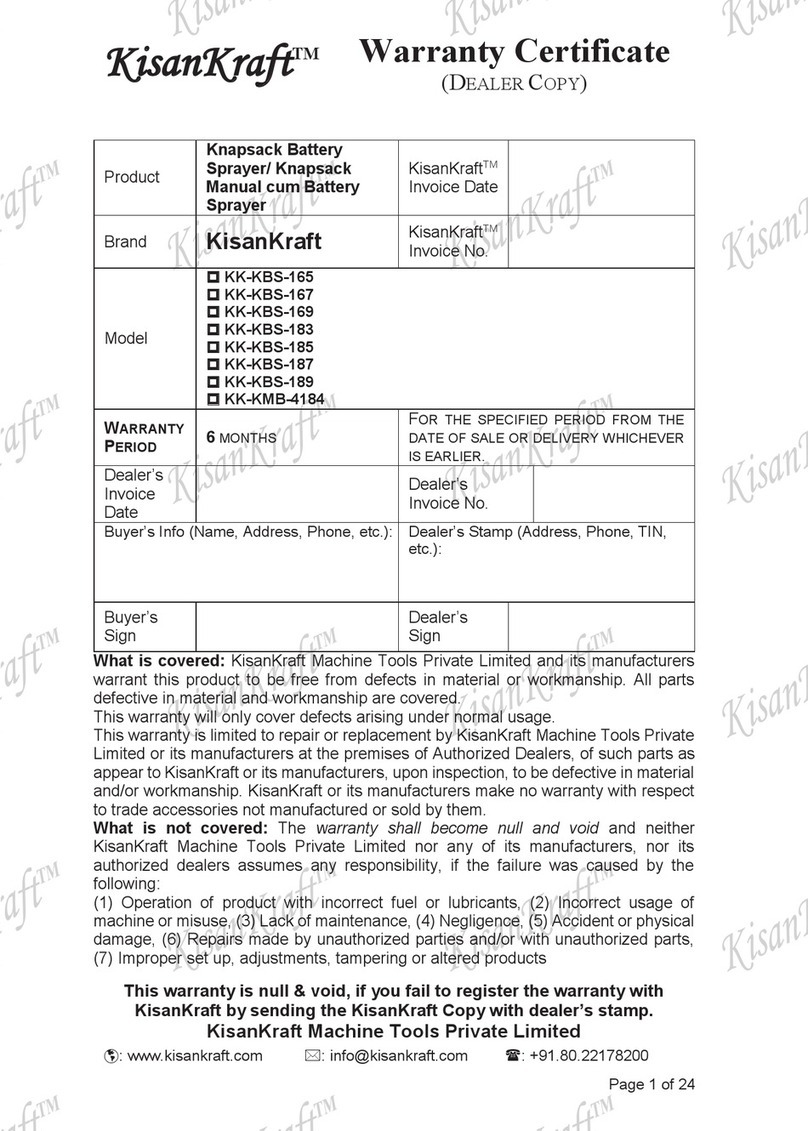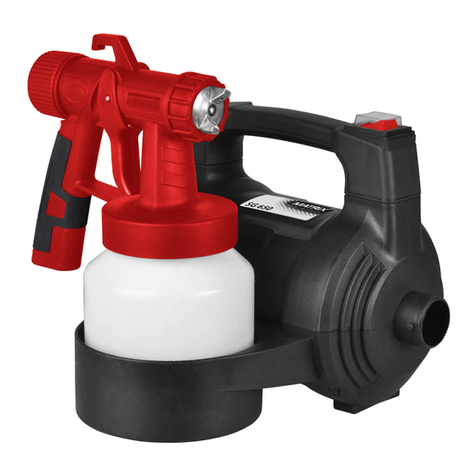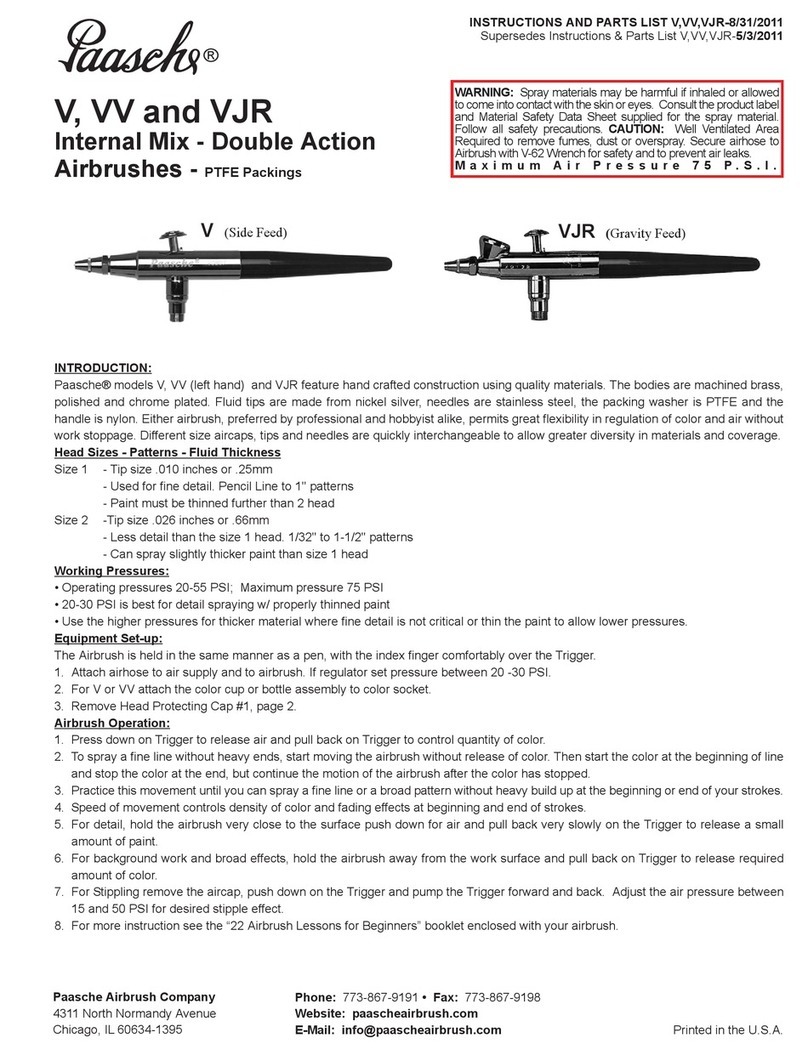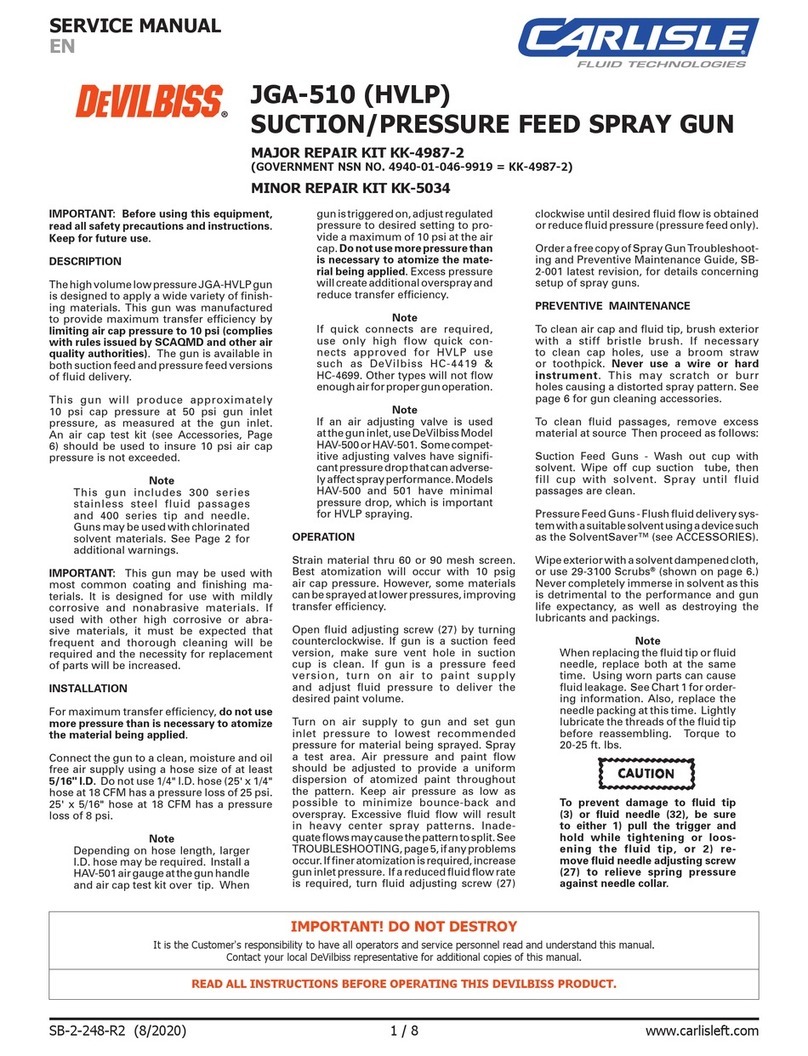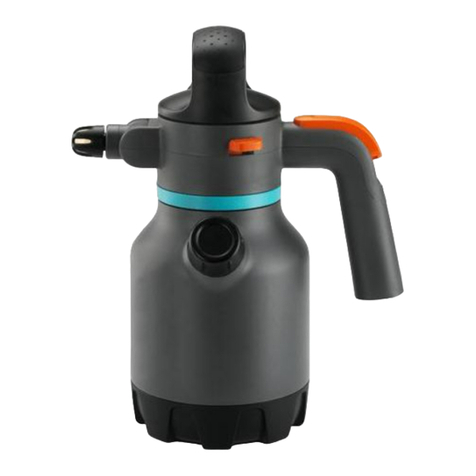
WARNING! The appliance is not to be used by persons (including children) with
reduced physical, sensory or mental capabilities, or lack of experience and knowledge,
unless they have been given supervision or instruction.
Young children should be supervised to ensure that they do not play with the appliance.
Beforeconnectingatooltoapowersource(mainsswitchpowerpointreceptacle,outlet,etc.)besure
thatthevoltagesupplyisthesameasthatspeciedonthenameplateofthetool.Apowersourcewitha
voltagegreaterthanthatspeciedforthetoolcanresultinseriousinjurytotheuser,aswellasdamageto
thetool.Ifindoubt,donotpluginthetool.Usingapowersourcewithavoltagelessthanthenameplate
ratingisharmfultothemotor.
TheASG-7000AirlessSprayGunoperatesatveryhighpressure.Forsafeoperationthefollowingmustbe
observed at all times.
• Donotpointthespraygunatyourselforanyotherperson.Injuryfrompenetrationtotheskinandpaint
solventsbeinginjectedintothebodycanresult.
• Alwayscheckforleaksandcorrectoperationbeforeuse.Neveroperatethespraygunifthereareany
leaks or faults. Faults or leaks can cause injury.
• Releasethepressurewhennotinuse.Pressurecanremainintheunitandhosewhenswitchedo.
• Alwaysremovetheplugfromthemainssocketbeforemakinganyadjustmentsorperforming
maintenance.
• Recommendations for the use of a residual current device with a rated residual current of 30mA or
less.
• NEVER under any circumstances aim the nozzle at another person or animal. In the event of an injury
occurring,seekmedicaladviceimmediately.
• Thespraygunmustnotbeusedforsprayingammablepaintsandsolventswithaashpointofless
than 21ºC.
• Alwaysensurethereisadequateventilationwhenspraying.
• The use of ear protection is recommended.
• Eye protection is recommended to keep hazardous vapours and liquids out of eyes.
• Alwayswearafacemaskwhenspraying.
• Alwaysreadthepaintmanufacturersthinninginstructionsbeforeusing.
• Alwayskeepthespraybasketnozzleinplaceduringuse.Neverallowthespraytocomeindirect
contact with the skin.
• Neverimmersethesprayguninliquid.Thiscouldleadtoelectricshock,personalinjuryandmaterial
damage.
• Thespraygunmustnotbecleanedbyusingammableliquidswithaashpointoflessthan21ºC.
• NEVERspraynearanakedame,includinganappliancepilotlight.
• NEVERsmokewhilstspraying.
• NEVERallowchildrentooperateorplaywiththespraygun.
• Beforecleaning,alwaysdisconnecttheappliancefromthemainssupply.
• Aftereveryuseensureyoucleanyourspraygunthoroughly.
• NEVERusethespraygunoutsidewhenitisraining.
• Injury where paint or solvent injection into the skin or body occurs can be very serious. Always seek
professional medical help and advise the paints or solvents used.
• NEVERusethespraygunwithoutthetriggersafetyguardtted.
• NEVERputyourhandinfrontofthegun.Gloveswillnotprovideprotectionagainstaninjectioninjury.
• ALWAYSlocktheguntrigger,shuttheuidpumpoandreleaseallpressurebeforeservicing,
cleaningthetipguard,changingtips,orleavingunattended.Pressurewillnotbereleasedbyturning
othemachine.ThePRIME/SPRAYvalveorpressurebleedvalvemustbeturnedtotheirappropriate
positions to relieve system pressure.
• NEVERuseaspraygunwithoutaworkingtriggerlockandtriggerguardinplace.
• Allaccessoriesmustberatedatorabovethemaximumoperatingpressurerangeofthesprayer.This
includesspraytips,guns,extensions,andhose.
• High-pressurehosesmustbecheckedthoroughlybeforetheyareused.Replaceanydamagedhigh-
pressure hose immediately.
• Neverpullonthehigh-pressurehosetomovethedevice.
• Donottwistthehigh-pressurehose.
• Donotputthehigh-pressurehoseintosolvents.Useonlyawetclothtowipedowntheoutsideofthe
hose.
• Laythehigh-pressurehoseinsuchawayastoensurethatitcannotbetrippedover.
• Followmaterialandsolventmanufacturer’swarningsandinstructions.Befamiliarwiththecoating
material’sSDSsheetandtechnicalinformationtoensuresafeuse.
• Uselowestpossiblepressuretoushequipment.
• Protectiveclothing,glovesandpossiblyskinprotectioncreamarenecessaryfortheprotectionofthe
skin.Observetheregulationsofthemanufacturerconcerningcoatingmaterials,solventsandcleaning
agentsinpreparation,processingandcleaningunits.
• ALWAYSfollowthematerialmanufacturer’sinstructionsforsafehandlingofpaintandsolvents.
• Do not spray on windy days.
• Never leave this equipment unattended. Keep away from children or anyone not familiar with the
operation of airless equipment.
WARNING!Whenusingmains-poweredtools,basicsafetyprecautions,includingthe
following,shouldalwaysbefollowedtoreduceriskofre,electricshock,personalinjuryand
materialdamage.
Readthewholemanualcarefullyandmakesureyouknowhowtoswitchthetooloinanemergency,
beforeoperatingthetool.
Save these instructions and other documents supplied with this tool for future reference.
Thechargerhasbeendesignedfor230Vand240Vonly.Alwayscheckthatthepowersupplycorresponds
tothevoltageontheratingplate.
Note: Thesupplyof230Vand240VonOzitotoolsareinterchangeableforAustraliaandNewZealand.
This tools is double insulated; therefore no earth wire is required.
Note: Double insulation does not take the place of normal safety precautions when
operatingthistool.Theinsulationsystemisforaddedprotectionagainstinjuryresultingfroma
possible electrical insulation failure within the tool.
Ifthesupplycordisdamaged,itmustbereplacedbyanelectricianorapowertoolrepairerinorderto
avoid a hazard.
Using an Extension Lead
Always use an approved extension lead suitable for the power input of this tool. Before use, inspect the
extensionleadforsignsofdamage,wearandageing.Replacetheextensionleadifdamagedordefective.
Whenusinganextensionleadonareel,alwaysunwindtheleadcompletely.Useofanextensionlead
notsuitableforthepowerinputofthetoolorwhichisdamagedordefectivemayresultinariskofreand
electric shock.
Thepowersupplyforthisproductschargershouldbeprotectedbyaresidualcurrentdevice(ratedat
30mA or less). A residual current device reduces the risk of electric shock.
SPRAY GUN SAFETY WARNINGS
GENERAL POWER TOOL SAFETY WARNINGS
ELECTRICAL SAFETY
WARNING! Readallsafetywarningsandallinstructions.Failuretofollowthe
warningsandinstructionsmayresultinelectricshock,reand/orseriousinjury.
Saveallwarningsandinstructionsforfuturereference.Theterm“powertool”inthewarnings
refers to your mains-operated (corded) power tool or battery-operated (cordless) power tool.
1. Work area safety
a. Keep work area clean and well lit. Cluttered or dark areas invite accidents.
b. Do not operate power tools in explosive atmospheres, such as in the presence of ammable
liquids, gases or dust. Powertoolscreatesparkswhichmayignitethedustorfumes.
c. Keep children and bystanders away while operating a power tool. Distractions can cause you to
lose control.
2. Electrical safety
a. Power tool plugs must match the outlet. Never modify the plug in any way. Do not use any
adapter plugs with earthed (grounded) power tools. Unmodiedplugsandmatchingoutletswill
reduce risk of electric shock.
b. Avoid body contact with earthed or grounded surfaces, such as pipes, radiators, ranges and
refrigerators. Thereisanincreasedriskofelectricshockifyourbodyisearthedorgrounded.
c. Do not expose power tools to rain or wet conditions. Waterenteringapowertoolwillincreasethe
risk of electric shock.
d. Do not abuse the cord. Never use the cord for carrying, pulling or unplugging the power tool.
Keep cord away from heat, oil, sharp edges or moving parts. Damagedorentangledcordsincrease
the risk of electric shock.
e. When operating a power tool outdoors, use an extension cord suitable for outdoor use. Use of a
cord suitable for outdoor use reduces the risk of electric shock.
3. Personal safety
a. Stay alert, watch what you are doing and use common sense when operating a power tool. Do
not use a power tool while you are tired or under the inuence of drugs, alcohol or medication. A
momentofinattentionwhileoperatingpowertoolsmayresultinseriouspersonalinjury.
b.Use personal protective equipment. Always wear eye protection. Protective equipment such as dust
mask,non-skidsafetyshoes,hardhat,orhearingprotectionusedforappropriateconditionswillreduce
personal injuries.
c. Prevent unintentional starting. Ensure the switch is in the o-position before connecting to
power source and/or battery pack, picking up or carrying the tool. Carryingpowertoolswithyour
ngerontheswitchorenergisingpowertoolsthathavetheswitchoninvitesaccidents.
d. Remove any adjusting key or wrench before turning the power tool on. A wrench or a key left
attachedtoarotatingpartofthepowertoolmayresultinpersonalinjury.
e. Do not overreach. Keep proper footing and balance at all times. This enables better control of the
power tool in unexpected situations.
f. Dress properly. Do not wear loose clothing or jewellery. Keep your hair, clothing and gloves away
from moving parts. Looseclothes,jewelleryorlonghaircanbecaughtinmovingparts.
g. If devices are provided for the connection of dust extraction and collection facilities, ensure
these are connected and properly used. Use of dust collection can reduce dust-related hazards.
h. Do not let familiarity gained from frequent use of tools allow you to become complacent and
ignore tool safety principles. A careless action can cause severe injury within a fraction of a second.
4. Power tool use and care
a. Do not force the power tool. Use the correct power tool for your application. The correct power
toolwilldothejobbetterandsaferattherateforwhichitwasdesigned.
b. Do not use the power tool if the switch does not turn it on and o. Any power tool that cannot be
controlledwiththeswitchisdangerousandmustberepaired.
c. Disconnect the plug from the power source and/or the battery pack from the power tool before
making any adjustments, changing accessories, or storing power tools. Such preventive safety
measuresreducetheriskofstartingthepowertoolaccidentally.
d. Store idle power tools out of the reach of children and do not allow persons unfamiliar with the
power tool or these instructions to operate the power tool. Powertoolsaredangerousinthehands
of untrained users.
e. Maintain power tools.Checkformisalignmentorbindingofmovingparts,breakageofpartsandany
otherconditionthatmayaectthepowertool’soperation.Ifdamaged,havethepowertoolrepaired
before use. Many accidents are caused by poorly maintained power tools.
f. Keep cutting tools sharp and clean.Properlymaintainedcuttingtoolswithsharpcuttingedgesare
less likely to bind and are easier to control.
g. Use the power tool, accessories and tool bits etc. in accordance with these instructions, taking
into account the working conditions and the work to be performed. Use of the power tool for
operationsdierentfromthoseintendedcouldresultinahazardoussituation.
h. Keep handles and grasping surfaces dry, clean and free from oil and grease. Slippery handles and
graspingsurfacesdonotallowforsafehandlingandcontrolofthetoolinunexpectedsituations.
5. Service
a. Have your power tool serviced by a qualied repair person using only identical replacement
parts. This will ensure that the safety of the power tool is maintained.

